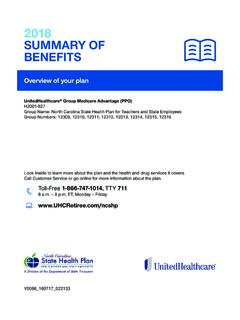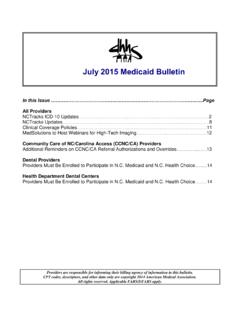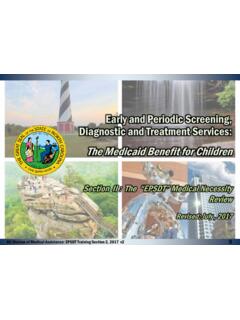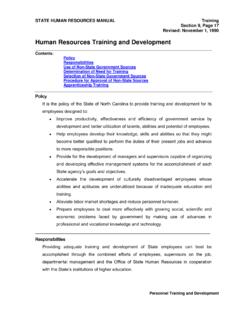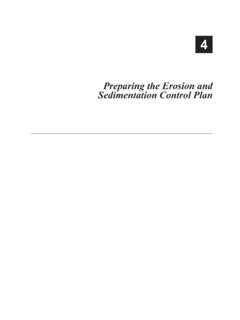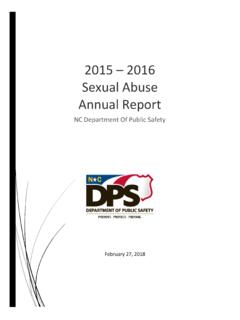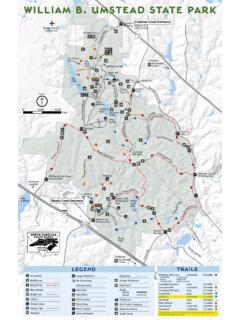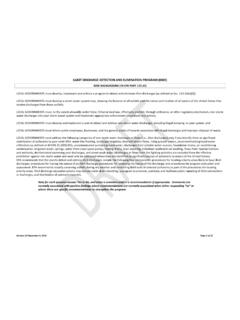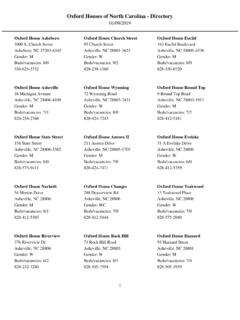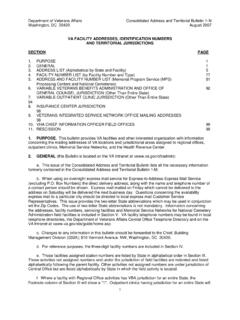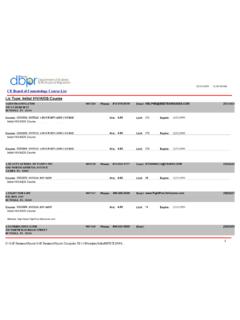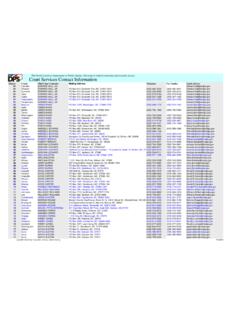Transcription of Dam Operation Maintenance and Inspection Manual
1 DAM Operation , Maintenance , and Inspection Manual 1985 (revised 2007)prepared by North Carolina Department of Environment and Natural Resources Division of Land Resources Land Quality Section I SUMMARY OF DAM EMERGENCY ACTIONS f your dam is failing or appears to be rapidly approaching failure, you should immediately activate the Emergency Action plan. As a minimum take the following actions: 1. Call 911 and the State Warning Point 1-800-858-0368 (this will mobilize assistance). Also, let the 911 operator know if there are roads below the dam that need to be blocked and if you need assistance in warning downstream residents. 2. Make sure that people living below the dam are warned to move out.
2 3. Call the Land Quality Regional Engineer in your area (see phone numbers on pages 3 & 4). 4. Open drain valves or spillway gates and begin lowering the reservoir. Warn downstream property owners of the increased flow. Common indicators of approaching failure are: Muddy water flowing from downstream slope or toe. Cracks or depressions forming on the dam or spillway. Movement or sliding on the surface of an earthen dam. Water flowing over the top of the dam, or rapidly approaching overflow. If you are in doubt about the seriousness of a problem, notify the nearest Land Quality Regional Engineer (see phone numbers on pages 3 & 4). A more detailed discussion of emergency actions and procedures is on pages 9-12.
3 I ii T PREFACE his Manual was developed to assist owners in their regular Maintenance , Operation , and Inspection activities. The information presented should also be valuable to many engineers. Emphasis has been placed on small earth structures, the dams most commonly found in North Carolina. However, much of the information will apply to dams of all types and sizes and also to dikes and levees. The Manual is divided into four basic sections: dam failures and emergency procedures; Maintenance of embankments; Maintenance of spillway and control structures; and Operation . Each of the sub-sections on Maintenance also covers items to look for during an Inspection .
4 The section on dam failures and emergency procedures covers indicators of potential failure and what to do in an emergency to save the dam and recommended procedures for warning downstream areas. An Index of Common Problems has been included at the front of the Manual following the Contents. Throughout the Manual , there are numerous recommendations to contact an engineer experienced with dams when certain observations are made. The importance of these recommendations cannot be over emphasized. Dams are complex structures and the causes and remedies of certain problems may not be obvious to a layperson. This Manual has been prepared for placement in a notebook.
5 The use of a notebook will provide space for the owner to include such items as past Inspection reports and correspondence, current Inspection observations, Operation and Maintenance records, plans and other construction records, if available, and any other information pertinent to the dam. This should provide a means whereby owners can keep accurate and up-to-date records of their dams. This Manual is an update of the 1985 version that was based on the 1983 Manual developed by the Ohio Department of Natural Resources, Division of Water, Dam Inspection Section entitled " Operation Maintenance and Inspection Manual for Dams, Dikes and Levees".
6 Special thanks are extended to Mr. J. Bruce Pickens, Administrator, Ohio Dam Safety Section for allowing this privilege. The funding for this edition was provided by the Department of Homeland Security (Federal Emergency Management Agency) by the State Assistance Grant under the National Dam Safety Program. iiiPREFACE iv CONTENTS SUMMARY OF DAM EMERGENCY ACTIONS .. i iii INDEX OF COMMON vii PART I INTRODUCTION Introduction .. 1 Parts of an Earth Dam .. 2 Dam Safety Laws .. 3 PART II - FAILURE AND EMERGENCY ACTIONS Earth Dam Failures.
7 7 Emergency Actions and 9 PART III - Maintenance OF EMBANKMENTS Vegetation .. 15 Erosion .. 19 Seepage .. 23 Treatment of Cracks, Slides, Sloughing, and Settlement .. 26 Rodent Control .. 29 Road on the Crest of the 31 Monitoring Devices .. 32 PART IV - Maintenance OF SPILLWAYS AND CONTROL STRUCTURES Inspection and Repair of Spillway 37 Trash Racks on Pipe Spillways .. 40 Inspection and Repair of Vegetated Earth 41 Concrete Repair .. 42 Mechanical Equipment .. 45 PART V - Operation Lake Drains .. 51 Mechanical Equipment .. 53 Reservoir Levels .. 53 Record Keeping .. 54 Winterizing Techniques and 55 56 Design Modifications.
8 57 Sedimentation and Dredging .. 58 Access Roads .. 60 Low-Head Dams .. 60 Contacting a Professional Engineer .. 61 Stocking 61 62 PART VI - Inspection , Operation AND Maintenance CHECKLISTS .. 63 77 79 CONTENTS v vi INDEX OF COMMON PROBLEMS 1. Emergency Procedures .. i & 9 2. Embankments (a) 15 (b) Tree and brush removal .. 15 (c) Erosion 19 (1) Vegetated 19 (2) At groin 20 (3) Wave erosion of upstream slope .. 20 (4) Footpaths, vehicle 19 (5) Ruts on crest .. 19, 31 (d) Seepage.
9 23 (e) 26 (f) Slides .. 27 (g) 27 (h) Animal Burrows .. 20, 29 3. Spillway 37 (a) 37 (b) Undermining at outlet .. 38 (c) Trash Racks .. 40 (d) Corrosion .. 38 (e) Leaks and piping .. 7, 37 4. Vegetated Earth and Rock Spillways .. 41 (a) 41 (b) Modifications or alternate uses .. 57 5. Concrete Repair and Repair of Cracks .. 42 6. Lake Drain Operation Problems .. 51 7. Sedimentation .. 58 8. Contacting an Engineer .. 61 INDEX OF COMMON PROBLEMS vii viii PART INTRODUCTION I ix x I INTRODUCTION n this Manual the word dam refers to an artificial barrier together with its associated (or appurtenant) works, constructed to impound or divert water or liquefied ma- terial.
10 The artificial barrier may be composed of timber, rock, concrete, earth, steel, or a combination of these materials. Associated works include spillways, and water supply and lake drain structures. Most dams in North Carolina have an earth embankment, one or two spillways, and a lake drain. Dams are complex structures subject to several forces that can cause failure. These forces are active over the entire life of the dam, and the fact that a dam has stood safely for years is not necessarily an indication that it will not fail. One of the forces inducing failure is seepage through the dam or its foundation. All dams seep, but if the seepage is too high in the dam it can cause a structural failure ("landslide" of the materials in the dam).
